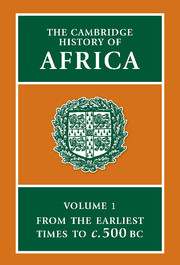Book contents
- Frontmatter
- 1 The palaeo-ecology of the African continent: the physical environment of Africa from earliest geological to Later Stone Age times
- 2 Origins and evolution of African Hominidae
- 3 The earliest archaeological traces
- 4 The cultures of the Middle Palaeolithic/Middle Stone Age
- 5 The Late Palaeolithic and Epi-Palaeolithic of northern Africa
- 6 The Later Stone Age in sub-Saharan Africa
- 7 The rise of civilization in Egypt
- 8 Beginnings of pastoralism and cultivation in north-west Africa and the Sahara: origins of the Berbers
- 9 The origins of indigenous African agriculture
- 10 Old Kingdom, Middle Kingdom and Second Intermediate Period in Egypt
- 11 Early food production in sub-Saharan Africa
- 12 Egypt, 1552–664 BC
- Bibliographical essays
- Bibliography
- Index
- Fig. 3.5 The distribution of sites known or believed to be older than 1.5 million years (i.e. Oldowan). (Modified from J. D. Clark 1967.)
- Fig. 3.6 The distribution of sites known or believed to be between 1.5 and 0.7 million years (i.e. Early Acheulian and Developed Oldowan).">
- Fig. 3.7 The location of Earlier Stone Age and Lower Palaeolithic sites thought to be between 0.7 and 0.1 million years old (i.e. Acheulian plus Developed Oldowan/Hope Fountain).
- Fig. 3.16 The ‘Zinjanthropus’ site at FLK, Bed I, Olduvai Gorge. A plan showing the distribution of an old ground–surface which was uncovered by excavation. A dense patch of discarded artifacts and introduced stones (manuports) coincides with a dense patch of broken–up animal bones. (After M. D. Leakey 1971.)
- Plate Section
- Plate Section
- Plate Section
- Plate Section">
- Plate Section
- Plate Section
- Plate Section
- References
1 - The palaeo-ecology of the African continent: the physical environment of Africa from earliest geological to Later Stone Age times
Published online by Cambridge University Press: 28 March 2008
- Frontmatter
- 1 The palaeo-ecology of the African continent: the physical environment of Africa from earliest geological to Later Stone Age times
- 2 Origins and evolution of African Hominidae
- 3 The earliest archaeological traces
- 4 The cultures of the Middle Palaeolithic/Middle Stone Age
- 5 The Late Palaeolithic and Epi-Palaeolithic of northern Africa
- 6 The Later Stone Age in sub-Saharan Africa
- 7 The rise of civilization in Egypt
- 8 Beginnings of pastoralism and cultivation in north-west Africa and the Sahara: origins of the Berbers
- 9 The origins of indigenous African agriculture
- 10 Old Kingdom, Middle Kingdom and Second Intermediate Period in Egypt
- 11 Early food production in sub-Saharan Africa
- 12 Egypt, 1552–664 BC
- Bibliographical essays
- Bibliography
- Index
- Fig. 3.5 The distribution of sites known or believed to be older than 1.5 million years (i.e. Oldowan). (Modified from J. D. Clark 1967.)
- Fig. 3.6 The distribution of sites known or believed to be between 1.5 and 0.7 million years (i.e. Early Acheulian and Developed Oldowan).">
- Fig. 3.7 The location of Earlier Stone Age and Lower Palaeolithic sites thought to be between 0.7 and 0.1 million years old (i.e. Acheulian plus Developed Oldowan/Hope Fountain).
- Fig. 3.16 The ‘Zinjanthropus’ site at FLK, Bed I, Olduvai Gorge. A plan showing the distribution of an old ground–surface which was uncovered by excavation. A dense patch of discarded artifacts and introduced stones (manuports) coincides with a dense patch of broken–up animal bones. (After M. D. Leakey 1971.)
- Plate Section
- Plate Section
- Plate Section
- Plate Section">
- Plate Section
- Plate Section
- Plate Section
- References
Summary
THE EVOLUTION OF THE CONTINENT
Geological structure and Precambrian history
The continent of Africa, second only to Asia in size, has an unusual combination of features and environments, including many extreme contrasts. It lies astride the Equator but, unlike South America, has northern and southern limits at almost identical latitudes (37°N and 35°S). However, this symmetry does not apply to area, for the northern portion is twice as large as the southern. Much of the interior of Africa, especially in the south, is an elevated plateau, capped in the east by the great piles of volcanic material that form the highlands of Ethiopia and East Africa. Cutting through these highlands are the trenches of the Great Rift Valley, occupied in part by important lakes, both deep and shallow. Volcanic cones form spectacular mountains with peaks rising almost to 6000 m above sea level and snow-clad despite their equatorial situation. In contrast there are areas in Egypt and Ethiopia that are as much as 120 m below sea level – Afar in the Rift system and the wind-scooped Qattara and other depressions in Egypt. In addition to the volcanic cones, there are other mountainous areas, but they are largely uplifted erosional remnants; true mountain chains are confined to the northern extremity (Atlas Mountains) and to the southernmost margin (Cape Ranges). The largest dry, hot desert in the world, the Sahara, stretches from the Atlantic to the Red Sea, forming a significant continent-wide barrier between the narrow Mediterranean littoral belt and the rest of the continent, often conveniently termed ‘sub-Saharan Africa’.
Keywords
- Type
- Chapter
- Information
- The Cambridge History of Africa , pp. 1 - 69Publisher: Cambridge University PressPrint publication year: 1982
References
- 2
- Cited by



